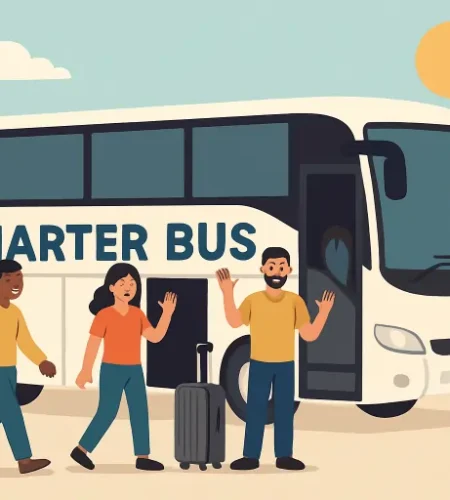Organizing a group bus trip doesn’t have to be overwhelming—with the right approach, it can be seamless and even fun. Whether traveling for a family reunion, corporate event, church outing, school trip, sightseeing adventure, or any special event, thoughtful planning ensures everyone feels included and relaxed. For groups departing from Central Texas, exploring an Austin charter bus rental is one of today’s most efficient and flexible transportation solutions. Charter buses take the stress out of travel by providing a coordinated, comfortable ride that keeps everyone together, simplifying logistics and helping you avoid issues like lost bags or missed connections.
Every successful group trip is built on a foundation of thoughtful coordination. When details like bus selection, scheduling, navigation, and communication are prioritized, participants can focus on enjoying the experience rather than stressing over logistics. From the earliest planning stages to the final farewell, careful organization minimizes confusion and paves the way for a smoother trip. The expert tips below will help guide you through every step, from booking the right vehicle to ensuring your passengers’ comfort and safety along the way, ensuring the journey is as memorable as the destination.
Choose the Right Bus
The foundation of any enjoyable bus trip is matching your group’s needs with the right vehicle. Consider group size first: Minibuses are ideal for smaller gatherings, as they offer nimble handling and easy parking for city excursions or short-day trips. On the other hand, full-sized coaches can accommodate larger parties and provide extra space for baggage and amenities. Think about how many people you’re transporting and whether passengers will need additional room for luggage, sports equipment, musical instruments, or mobility aids. Long journeys may warrant choosing buses with reclining seats, onboard restrooms, individual reading lights, power outlets for charging devices, climate control, and Wi-Fi, which keep travelers comfortable and entertained en route. When evaluating options, factor in every attendee’s mobility and preferences so everyone can ride comfortably and in style. Then, reach out to providers willing to customize solutions for your requirements. Selecting the right bus is the cornerstone of a successful trip and should always be a top priority during the planning phase.
Plan and Book in Advance
Booking your transportation early ensures you secure your desired vehicle and itinerary, especially when traveling during busy seasons, to popular destinations, or during major holidays and local events. Early reservations offer the best selection and competitive rates and allow you to communicate special requests to the bus company—like accessibility features, booster seats for children, and extra storage space for sports or musical equipment. Finalizing travel details allows the group more time to prepare and anticipate the journey together. Advanced planning also allows you to compare rental providers, review contracts, understand cancellation policies, and ask plenty of questions, reducing the risk of last-minute surprises or disappointments.
Create a Detailed Itinerary
Transparency and planning are key to a smooth bus trip. A clear, detailed itinerary answers travelers’ most common questions: When do we leave? Where will we stop for meals or rest breaks? What activities are planned at each stop? Include precise departure and arrival times, addresses, planned stops, meal breaks, sightseeing locations, and contact information for group leaders or guides. Share your itinerary digitally through group calendars, messaging apps, or printable handouts so all participants know what to expect. Consider adding details about meal options, local attractions, or important reminders for each leg of the journey. Allowing time for flexibility within the itinerary keeps the experience relaxed, while providing a reliable structure that minimizes confusion throughout the journey.
Establish Clear Communication
Centralized communication reduces confusion and makes swift updates possible if things change. Choose a dedicated communication channel for the group—like WhatsApp, GroupMe, Facebook Messenger, or Slack—and designate one or two point people as contact leads. These individuals will act as liaisons between the group and the bus provider, hotel staff, event coordinators, and other vendors, helping to relay crucial information in real time and resolving any urgent questions from travelers. Share a contact sheet featuring all key phone numbers before departure. By keeping everyone in the loop before and during the journey, you can avoid mix-ups, manage expectations more effectively, and help prevent anyone from feeling left out or uninformed in case of schedule changes or emergencies.
Manage Expenses Effectively
Financial transparency is crucial when costs are split among a group. Set a clear budget that covers transportation, accommodations, meals, tickets, and incidental expenses upfront, and share this information with all participants. Leverage easy-to-use apps like Splitwise or Venmo to document and manage group payments, ensuring everyone knows their share and can contribute without hassle. Collecting funds in advance, when possible, streamlines payments and prevents awkward situations later. Keep a small contingency fund available for emergencies to avoid unexpected out-of-pocket costs for anyone. Track all receipts, keep an expense log, and update group members regularly to maintain trust and accountability throughout the planning process.
Prioritize Comfort and Safety
Working with a reputable charter company is non-negotiable—research their safety record, vehicle maintenance routines, and driver qualifications beforehand. Every passenger’s well-being matters, so confirm that the bus meets or exceeds safety standards and that the driver has ample experience with your group size and travel distance. Schedule regular pit stops so all guests can stretch and rehydrate, especially for longer trips, to help reduce fatigue and increase overall comfort. Ensure seatbelts are available and functional for all travelers, and that the company follows established safety protocols. You can review additional passenger safety tips from Consumer Reports for extra peace of mind. Emergency contact information and any necessary medical or allergy information should be collected from participants ahead of time in case of unexpected situations.
Prepare for the Journey
Encourage travelers to pack personal essentials for the road—snacks, water bottles, headphones, entertainment like books or games, travel pillows, and any necessary medication or comfort items. Preparing a simple comfort kit can significantly impact a longer journey. Set basic expectations around punctuality, cleanliness, and group conduct in advance to help everyone get the most from the experience and keep the atmosphere friendly and collaborative. Discussing these norms up front fosters harmony and helps avoid misunderstandings later, especially if there are children or elderly participants. A checklist shared before departure can be a helpful reminder and lift the group spirit, ensuring everyone shows up ready and excited for the trip.
Conclusion
Effectively organizing a group bus trip balances thorough planning with flexibility and communication. By matching your group to the right bus, booking well in advance, designing a detailed itinerary, streamlining communication, managing expenses openly, prioritizing safety, and encouraging thorough preparation, you pave the way for a smooth and genuinely enjoyable group adventure. With these strategies, travelers can share memories on the journey, not just at the destination. Embrace the planning process as part of the adventure, and your group will be set for an experience to remember long after the journey ends.
Read more: How to Style Wedge Boots for Every Season – The Funny Puns
What CPAs Can Help You With – The Funny Puns
The Emotional Impact of Workplace Injuries and Recovery – The Funny Puns


Comments